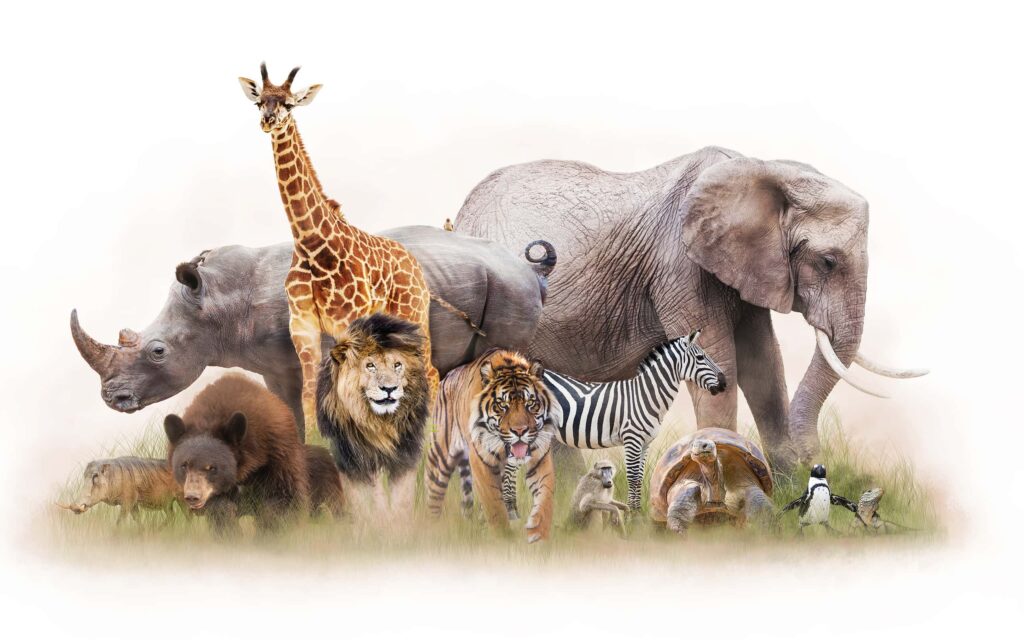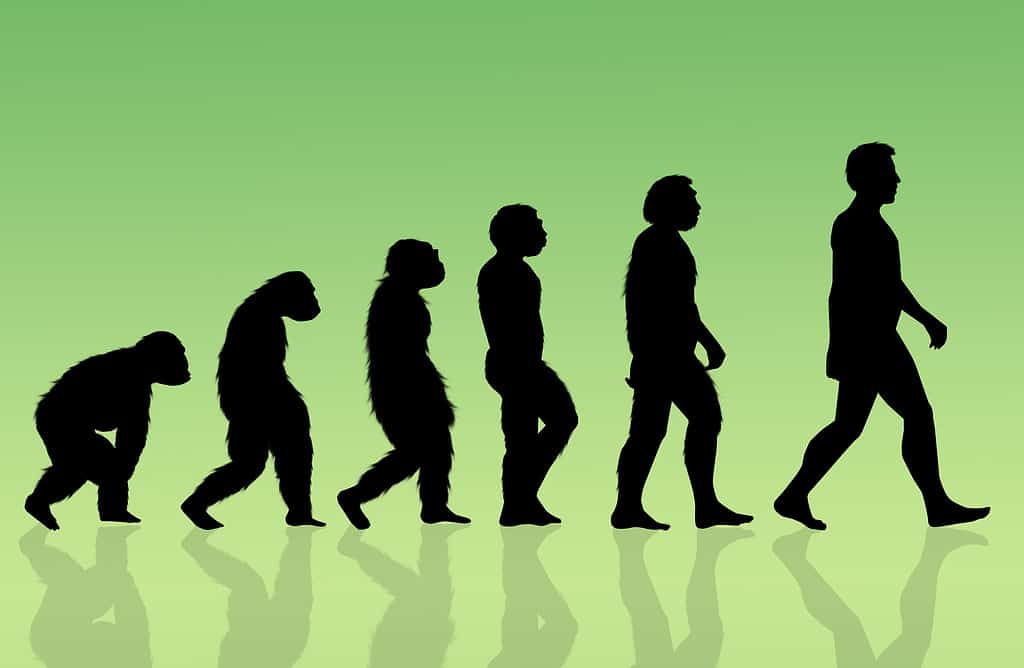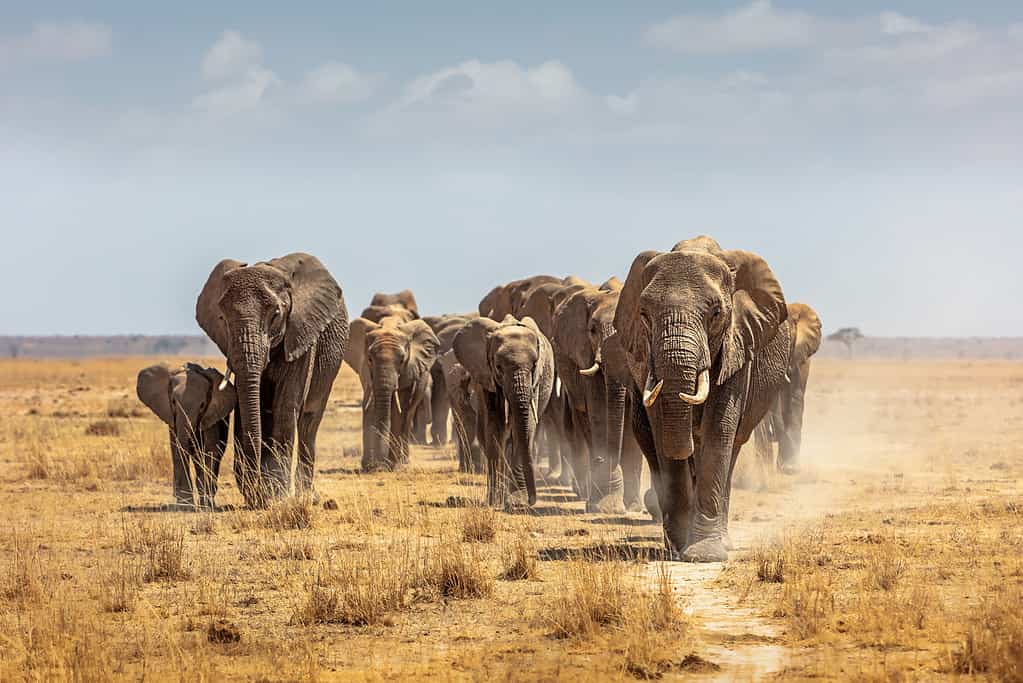
Ultimately, we can answer this question in two ways. Why did life on Earth evolve onto land with four legs? And, why did most life remain on four legs, or skip three legs to go straight to two legs?

Four-legged creatures evolved from fish. In order to orient themselves underwater and propel their bodies to catch prey or avoid predators, prehistoric (and modern) fish needed a certain number of fins. As life began to expand onto land around 360 million years ago (either to escape being eaten or in search of easier food to eat), these fins helped fledgling fish navigate and move on the sand and stone near the water. Over millions and billions of years, these fish evolved into amphibian-like creatures who could breathe on land. At the time, their fins functioned as limbs capable of walking on land.
Naturally, small evolutionary changes made some fins better at walking on land than others. The fins that made the evolutionary leap to legs were the four on the bellies of the fishes that evolved to live on land.
Interestingly, this transition from fins to legs was surprisingly simple. The legs that carried our amphibian ancestors along the beaches were not that much different than the fins of their fishy relatives. There were many types of fish, and many of them had unique skeletal structures that allowed some to more easily adapt to life on land. In other words, the leap from water to land wasn’t as significant for some species as we might believe.
As these animals (known as tetrapods) evolved to live exclusively on land, they kept the four-legged skeletal structure. Subsequent evolutionary changes improved upon the four-legged system.
As you might have noticed, there are other animals with more than four legs. These include many types of insects, mollusks, and crustaceans. It might seem strange that our four-legged ancestors evolved into such diverse species with six, eight, or even hundreds of legs, but the truth is much simpler. These creatures actually evolved separately from the mammals, lizards, birds, and other animals we know. Their evolutionary history, including the growing of many pairs of legs, has allowed them to adapt and thrive in environments and against dangers that other animals don’t have to deal with. Including a detailed description of how and why these animals evolved in the way they did would take much longer than we have space here to do!

The evolution from exclusively four-legged locomotion to two-legged happened for several reasons. Often it happened in different species at the same time. This is called convergent evolution. For example, the dinosaurs evolved over millions of years to walk on two legs. This evolution allowed them to move faster and be more efficient with their energy.
It is easier for two symmetrical limbs to evolve and develop into new functions than for a new limb to grow from scratch. As some animals evolved to walk on two legs, the front legs evolved to take on new functions. Because these front limbs were more than capable of fulfilling these new functions (like eating, grasping, and climbing), and the rear legs were able to walk without issue, there was no evolutionary need for a third limb to join the party. Adding a third leg to two-legged creatures would be an evolutionary backstep. It would make a more efficient mode of locomotion less efficient.

Evolution uses tools such as mutation, gene flow, natural selection, and genetic drift to allow species to adapt to their environment. It is important to remember that evolution builds upon the resources already present in living things. Additionally, only those changes that allow an animal to be more successful than its competitors will be passed on through successive generations. Mutations and other changes that make the animal worse at hunting, running, mating, or any other activity will be filtered out through natural selection.
The first tetrapods to crawl along the banks of primordial oceans had two pairs of legs. These legs evolved from the four fins on the bellies of the fish that wriggled along the sand. Any mutation and genetic drift that occurred would have been working on the four legs that already existed.
Some of those legs grew longer to help animals reach leaves in tall trees. Others grew into wings as birds evolved. Some developed longer digits to help with grasping and manipulating food and objects, and so on. In every case, the front pair developed together and the rear pair evolved together. This is because both pairs of limbs are determined by the same genes. So, a change in the genes for these limbs would affect both limbs at the same time.
If there were three-legged animals, there would have had to have been some evolutionary reason for that to happen. This adaptation would have occurred because three legs gave some kind of natural advantage to that creature over the other animals in its community. This is simply not the case. There is no case in which three legs performed better than two, four, or even no legs.
Mutation and genetic drift are always happening. Slowly over billions of years, changes happen and the most beneficial ones are carried on through generations. It is reasonable to theorize about an ancient animal that might have had some proto-third-leg. Yet, because it gave no advantage to the creature who had it, it was not passed on.
In every case, three legs would be slower and less efficient than even-paired legs. Some animals (like snakes and whales) once had legs, but those limbs slowly disappeared. They now have sleek bodies that allow them to slither (for snakes) or swim smoothly (like whales) because even no legs are more efficient than three legs.
Most living things have symmetrical bodies. Why this is the case is the subject of much study. However, there are some theories. One hypothesis says that symmetrical structures use fewer genes and are therefore less complicated. So, they are more likely to evolve and adapt.
When there are fewer things that need to evolve in order for successful genetic change to be passed on, the likelihood of beneficial changes occurring increases. Non-symmetrical bodies, which would include three-legged creatures, would be more complicated, and less likely to evolve.
Even if there were three-legged animals somewhere in the distant past, it would have been left behind by evolution since it would not have been able to adapt and change with the environment as efficiently as animals.
Evolution tends towards the simplest form of an organism. Extra limbs, organs, or features that are not being used will slowly disappear or be adapted into new functions. Limbs that are in the process of evolving away are called vestigial limbs. This process is called vestigiality.
Humans have several vestigial features. The parts of our bodies that are disadvantageous or serve no function are slowly disappearing from our bodies over millions of years. This leaves us with the simplest form of our bodies, where each part serves a streamlined function. It may sound strange, but three legs would be an even more complicated form than four or eight legs. And since four or eight legs would be more beneficial to an animal than just three, evolution tends toward the simplest and most efficient form.
Finally, three legs would be a significant disability for any animal. There is no environment in which three legs would not be a hindrance to movement or other necessary biological functions. Three legged animals would not be able to run as fast as four-legged animals. And they would also not be as efficient as two-legged animals. For every two-legged animal (apes, birds, and some other species), three legs would simply make climbing, walking, running, and sleeping more difficult. If some animal were to suddenly sprout a third limb, its detrimental impact on its quality of life would guarantee this new development would not be passed down to later generations.